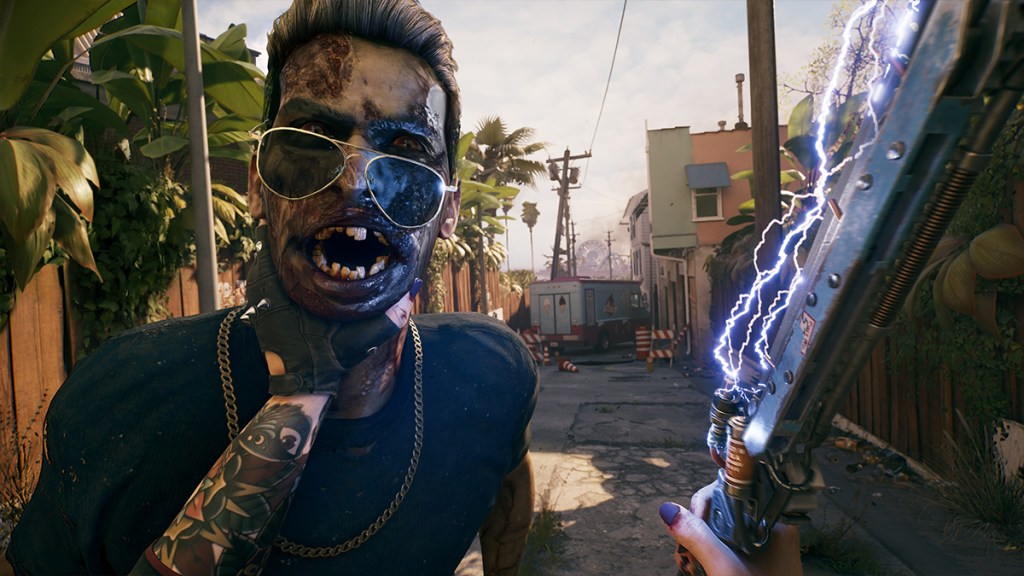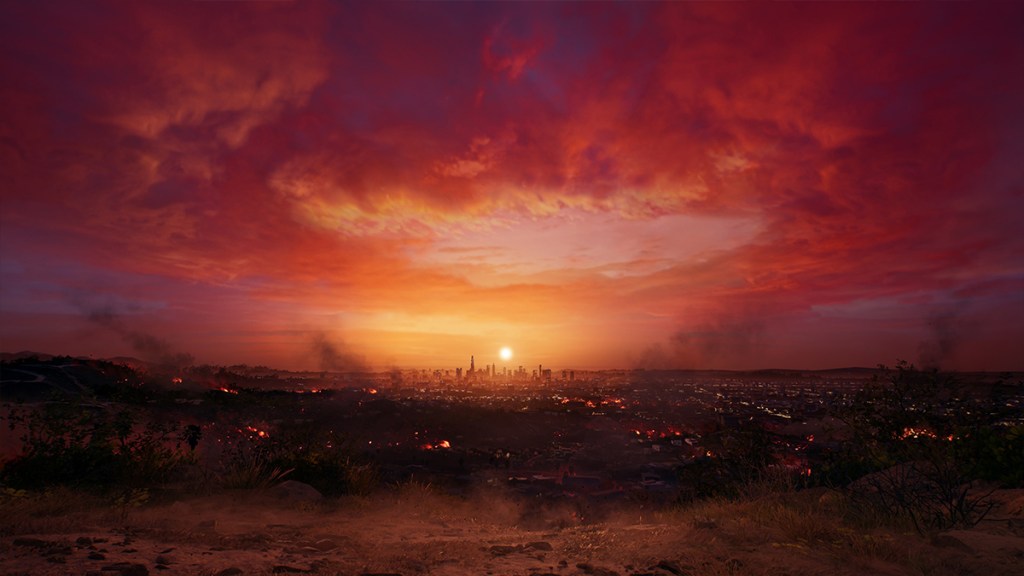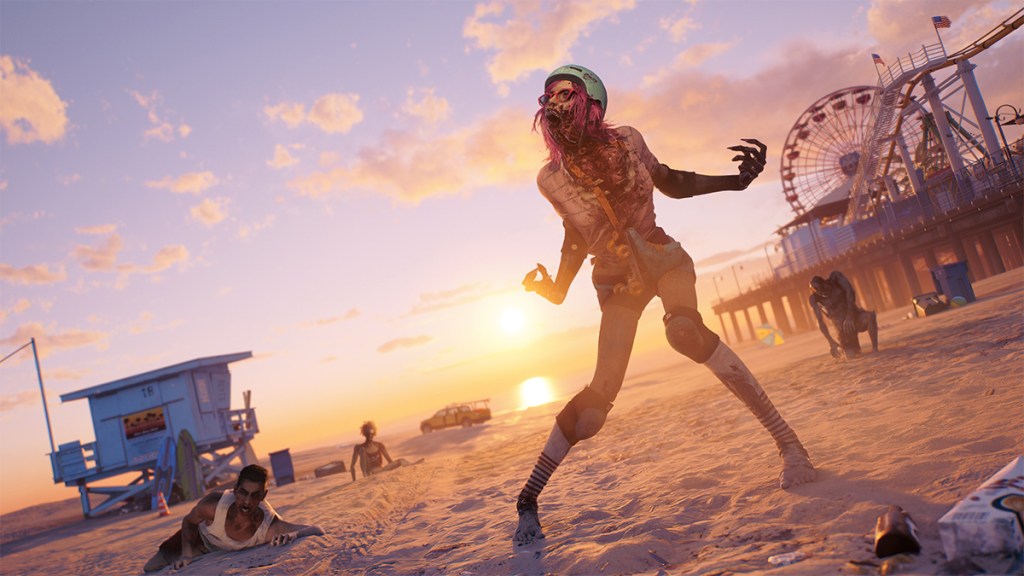Dead Island 2 has gone through enough teams and years in development to make it seem destined to underwhelm. It’s a hellish fate reserved for cursed titles like Too Human, Aliens: Colonial Marines, and Duke Nukem: Forever, games so bad that their memories only serve as cautionary tales. But against all odds, Dead Island 2 is surprisingly promising in a way that goes completely against what its rocky development implies.
But to be fair, Dambuster Studios’ version of the game has only been in development for around four or so years, meaning that the same dated husk of code hasn’t been transferred from developer to developer over the last decade through an undoubtedly damned pile of hard drives. And as such, this final version of Dead Island 2 feels like a normal and modern game, one with multiple interesting systems at its core.
The combat is the most intriguing part of the package since it has many layers, which, in a literal sense, applies to its F.L.E.S.H. System. This forced but functional acronym stands for Fully Locational Evisceration Simulator for Humanoids and means that a zombie’s body will react to where they’ve been damaged, tearing through skin, muscles, bones, and organs along the way. If players bludgeon a zombie’s chin with a giant hammer, their jaw might dangle off their head. If they stab a zombie in the belly, their stomach could fall out of that newly created hole.

This procedural system is disgusting since viscera and bones are constantly spilling out with every other blow, and it’s an incredible sight not only because of how excessive it is, but also because of how organic it feels. Seeing a zombie take damage that’s localized to where it was struck is more rewarding than just seeing a health bar go down since it is much more nuanced than the canned damaged models seen in other games.
And this nuance has gameplay ramifications since a crippled zombie won’t have access to their full suite of attacks. Clipping a Crusher’s arms means it can do a big ground pound, while slicing off a Runner’s legs means it can’t live up to its colloquial namesake. Sadly, the RPG systems might limit this since, as annoying as it is in other games, there’s some level gating that can arbitrarily make some zombies extremely hard to kill for no reason other than the number above their head.
Design Director Adam Duckett had nothing but good things to say about the dynamic F.L.E.S.H. System. He fondly recalled the early design meetings for the game and how it all came together in the end.
“You want that instant feedback, that feel, that connection, so then when you do sever the arm, it sort of reflects anywhere up there,” said Duckett. “That’s kind of really how it started. We wanted the gore to reflect the damage that the player had done to the zombie. We really wanted to give players that immediate feedback. So if you were, for example, to turn the HUD completely off and just keep hammering away at the zombie, you’d see the damage and understand how much health damage you were doing.”
However, Dead Island 2, while exponentially more technically savvy than its buggy predecessors, doesn’t have the one of Dead Island or Dead Island: Riptide’s more beloved features: the analog combat system. This optional control method let players control melee swings with the analog stick, allowing for a level of precision a button press can’t have. It would theoretically work incredibly well with the F.L.E.S.H. System, given how granularly body parts can be targeted, but it’s not here and Duckett was not keen on detailing why.

Regardless, the F.L.E.S.H. System is just one way that combat stays fresh, as Dead Island 2 has a few emergent systems that encourage players to observe their environments and think of interesting combos. Judging by the early hours, there are poison, fire, and electrical status effects that players can manipulate. Weapon mods are the more straightforward way to electrocute a zombie, but there are also batteries that can be pulled out of cars, destructible electronic traffic signs, and stray electrical wires, to name a few, that can also act as electrical conduits.
The multiple water sources in the game — including water cans players can use to manually douse the environment — open up the possibilities even more and give smart players the means to create combos. Every element is naturally integrated in the world like this, too, and there are even Curveballs, special throwables tied to a cooldown meter, that give players ever more ways to manipulate the world and those within it. This flexibility also paves the way for emergent moments, which are always a delightful microcosm of the unique properties of the medium.
Duckett also thought back to the early design meetings where he declared that the game should be about “killing zombies in interesting and innovative ways.” He explained that placing everyday items all over the sandbox and looking at it from different angles was key in giving players a variety of ways to overcome challenges. Duckett also said he hoped that the depth of the tools meant players could discover new things on their second and third playthroughs.
“It was a really early decision that we made that we didn’t want the worlds to be static,” he said. “We wanted to have them physicalized and we wanted to give players opportunities in any given combat scenario. We were looking at different fluid types, so we have a lot of methods of getting different fluids into the scene, albeit through pipes or be it through Curveballs or be it through the environment. And then we wanted the different elemental opportunities again through Curveballs, weapons, the environment, or through skill cards and how they combine together to give people plenty of opportunity to engage.”

Duckett said that Dead Island 2’s smaller spaces meant Dambuster could make them more dense and full of items to interact with. Dead Island 2 is surprisingly not an open-world game in the traditional sense; its levels are specific zones tied together by loading screens. It may seem initially limiting to not have unbridled freedom to explore Los Angeles from the jump (and hopefully it doesn’t feel like that in the full game), but it’s much more intriguing to have a more focused game over acres of generic filler, especially given how detailed and jammed with items each building is. Duckett acknowledged that endless, 120-hour games aren’t for everyone, including himself (“I have two kids.”), and said that having a more constrained scope was a decision the team made early on.
“We wanted to focus on quality over quantity, both in the content that we can add in, the quality of the environment, the visual quality, and also to make sure that we were putting a lot of focus into the core of the game, which is our brutal zombie combat. We really wanted to make sure that the environments were great playgrounds and great sandboxes for players to engage with zombies up close and personal.”

These interconnected hubs make up Dead Island 2’s exaggerated version of Los Angeles, which is a culturally ripe setting for an over-the-top game like this. Players will slay zombies in the backyards of the rich and famous, pilfer through influencer incubation houses, and come across any number of walking stereotypes who embody the local glitz and glamor not even a zombie horde can kill.
Despite being full of undead, the early sections are lively in their own right due to the exorbitant and personality-rich nature of the area, but also because of the writing. Dead Island 2 is surprisingly sharp with its ridiculous characters that are miraculously not annoying and laugh-out-loud funny at times. The first few hours had characters that were the aforementioned walking stereotypes, but were written well enough to not just be a checklist of grating clichés. Even one of the main characters, Jacob, embodies cool and only chimes in when he has a lighthearted quip or something meaningful to contribute. It’s unknown if all of the protagonists will be as charismatic or if the growing roster of secondary characters will be as likable as the game progresses, but the first few missions bode well.
That is applicable more broadly, too, because the opening hours of Dead Island 2 were promising in a way that was previously thought to be nearly impossible. The satisfyingly gory melee combat and number of available tools to tinker imply that this zombie-killing game won’t be as brainless as some of its peers, and the more concentrated world seems like it will benefit both the story and gameplay. It’s difficult to have faith in any game called Dead Island 2 after the saga it, in one form or another, has gone through, but Dambuster has overcome a lot of that stigma by showing something that looks quite awesome.










